What’s In The Market For 2023?
Source: www.TurfMagazine.com
Bigger, badder, battery-operated everything. And robots!
Depending on your perspective, the professional lawn care and land-scape Industry is either ripe with exciting new opportunities or frustratingly full of changes. Today, the Green Industry is undergoing dynamic and revolutionary shifts in many facets of once basic practices—from mowing to pest control. Robotics, battery power, increasing legislation, new tech options, and consumer attitudes are driving the Industry toward new types of equipment, new ways of working, and essentially, new ways of thinking.
“Regulations are popping up at city and town levels that landscapers are having to deal with, changing the way they provide services,” comments Kubota Senior Turf Product Manager Tom Vachal. “Most notably [with] gas-powered backpack blowers. Many areas are pushing for electric solutions, sometimes driving up the input costs which are being absorbed by the landscaper.”
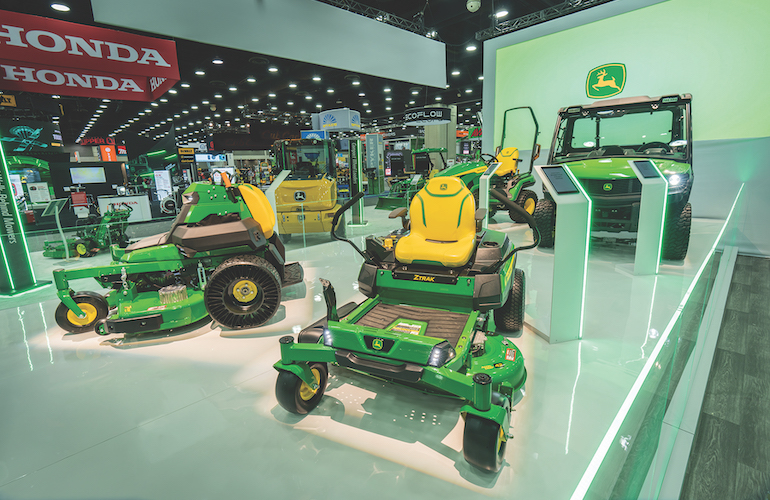
In addition to large, long-term Industry transitions such as battery power, are the more immediate and present issues. “Competition is increasing as the market gets tighter; this is compounded by labor shortages, inflation, and supply chain issues,” says Rick Agajanian, chief product officer at WorkWave. Vachal echoes these concerns, but is optimistic, “Some supply chain issues still exist in the landscape industry, but we do expect improvement in 2023 moving forward.” He adds, “Labor will continue to be a pinch point, but some minor improvement is expected in mid-2023.”
“The landscape industry is being challenged on many fronts—labor, emissions, replacement parts, and environmental stewardship just to name a few,” says Scythe’s Director of Marketing Billy Otteman. “To differentiate themselves, savvy contractors are beginning to make changes in their business to attract personnel and customers.”
Brian Rowan, SiteOne VP of category management, comments, “With an unknown economic outlook in 2023, efficiency is the name of the game. Green industry professionals will continue to be challenged with labor shortages, making it crucial for suppliers to work ahead to support contractors’ needs to help teams be as productive as possible.”
Yet despite the gravity of both long-term and short-term challenges, many agree the Industry still looks quite good moving into 2023. “Despite the challenging atmosphere, revenue for Green Industry companies has been strong overall,” comments Agajanian.
Vachal states, “Landscapers continue to expand their service offerings to increase the amount of work they are doing for their customers, [and] make more [money] at new locations and with good customers. There also continues to be some consolidation among landscape companies. I expect this trend to continue.”
Yes, the Industry has been booming, but how long will the ride last? And at what point do you start future-proofing to ensure longevity in an era of major Industry change?
More Electric Mowers, Many Firsts
Back in 2020 at the GIE+Expo, there was a unique and crowded attraction: a Husqvarna Automower set up on an angle and zipping up and down the display. While exciting, autonomous robotics still seemed like a bit of a novelty in the U.S. It was the growth of battery-powered equipment that was on the tip of every tongue at that Show. Yet the battery-powered options and introductions were largely limited to small engine and handheld equipment.
A mere two years later, at the renamed Equip Expo this past October, it seemed as if nearly every other booth had a robotic and/or battery-powered mower. Not just small mowers either. Large zero-turns were debuting. Of course, many introductions were still in prototype phase, but the writing is clearly on the wall.
A large driver is California’s recent legislation. “California recently became the first state to pass legislation that will drive the transition to emission-free equipment starting in 2024. Similar laws are becoming more prevalent throughout the U.S., resulting in the Landscape Industry experiencing a growing trend for requirements around the use of emission-free and low-noise equipment in businesses, municipalities, HOAs, resorts, and hospitals,” says Anthony Buxton, group product manager at Milwaukee Tool.
He continues, “To stay ahead of this trend, landscape professionals have had to begin analyzing their purchasing decisions as the number of cities and states considering legislation enacting such regulations continues to grow. Many landscaping businesses and professionals are evaluating the transition from gas to battery-powered equipment to be their primary equipment solution.”
Jack Morrison, co-founder and CEO of Scythe Robotics, echoes the sentiment. “The Industry is hungry for technology solutions that not only solve some of its biggest needs like labor and productivity, but also deliver the environmental benefits of zero emissions and quieter mowing.”
Indeed, reservations for Scythe’s commercial grade autonomous mower, the M.52, surpassed 5,000 in late May of 2022, including large Industry clients like Yellow-stone Landscape, Clean Scapes, and Impact Landscaping & Irrigation. Scythe will continue to accept reservations for M.52 as it ramps manufacturing to reach full-scale production in 2025.
Bobcat threw its hat in the ring of robotics with the announcement of its new autonomous mowing system—as well as a strategic investment in Greenzie, an autonomous software company for commercial lawn mowers and outdoor power equipment. Designed to operate with soft-ware developed by Greenzie, the company’s first electric zero-turn mower, the Bobcat Zt6000, has a ride-and-repeat feature where operators can plot a course and mark areas for the mower to avoid during autonomous operations. Able to detect objects, known or unknown, the mower travels its prescribed path, utilizing mapping to execute an exact route; which can be managed on a smartphone app.
“Our customers are desperate for solutions that help them overcome their biggest challenge: labor shortages,” comments Charles Brian Quinn (CBQ), co-founder and CEO of Greenzie.
While not autonomous, Exmark has launched its first electric commercial walk-behind mower— the Commercial 21 V-Series. “The Commercial 21 V-Series makes it easier for landscape contractors to work in zero engine exhaust emission areas, or HOA quiet zones,” says Jamie Briggs, director of marketing at Exmark.
SCYTHE

HUSQVARNA
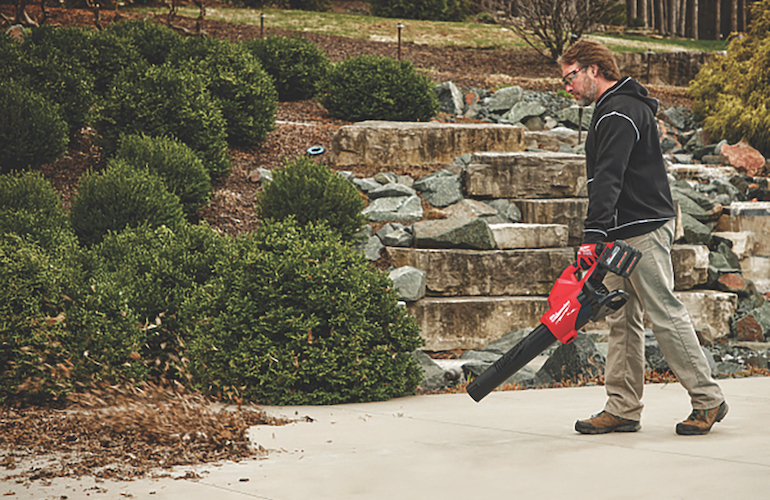
MILWAUKEE TOOL
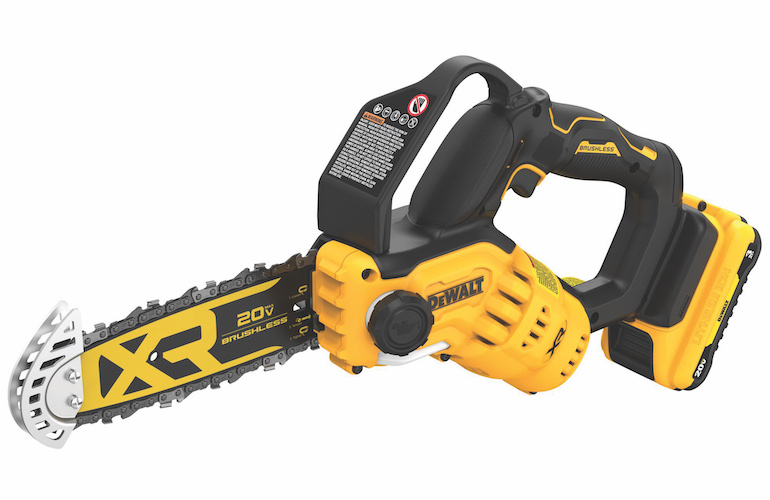
DEWALT
At just under 81dB of measured sound output, the Commercial 21 V-Series operates well below the OSHA 85dB threshold for hearing protection. A rechargeable 60 Volt 7.5Ah lithium-ion Professional Power System provides up to 40 minutes of run-time per charge, depending on conditions. The 5.5A rapid charger provides 90% charge in 75 minutes. Two 60V 7.5 Ah batteries and a rapid charger are included.
DEWALT® also unveiled its first introduction in a coming lineup of electric outdoor power equipment for professional landscapers: the Ascent zero-turn mower Series. The Ascent Series will offer a total electric solution with smart technology beginning in Fall 2023.
The Series features the C-60, the first-ever mower with 2-in-1 crossover functionality between a stand-on or seated mower. The conversion can be made in seconds (I’ve seen it done). An R-60 sit-only model will also be available.
The Ascent Series will feature swappable, 3.2 kwh lithium-ion batteries with capacity for up to five batteries. The Ascent will also feature a H-E-2™High-Efficiency Deck featuring three spindles, each with dual-blade technology and four cutting surfaces. Complemented by the GroundCommand app, Ascent mowers will give fleet managers real-time visibility into the operational status of each mower. Cellular connectivity will provide live intel about battery life, blade operation, location, driving status, charging status and more with the ability to customize thresholds and notifications.
Want autonomy as an option, but not a must? Husqvarna has been showcasing a prototype of a semi-autonomous stand-on mower. It’s designed for traditional use when needed, but features an autonomous operation mode that frees up the operator to work simultaneously on other tasks, such as trimming, edging, and blowing.
“Battery, robotics and autonomous solutions are unquestionably the future of land-scaping,” said Carlos Haddad, Vice-President of North America, Professional Business Unit, at Husqvarna Group. “Given that every property, workforce, even municipality is not the same, the best way for professionals to be strategic and successful is to be cognizant of and engage those products and services that offer solutions for every aspect of their business.”
Not surprisingly, then, Husqvarna has also introduced an all-new line-up of commercial battery-powered professional products, which are set to be released in 2023. The line-up addresses essential performance needs while meeting impending regional emissions and noise regulations.
More Electric Everything
Bigger, badder, battery-operated mowers aren’t the only new electric equipment on the horizon. While Steel Green recently introduced its largest sprayer yet, the SGXL, to meet the needs of lawn pros who service commercial or large residential lawns, it also introduced a prototype SG36-EV, the first all-electric ride-on spreader/sprayer on the market.
“Across the industry’s product categories, professional users are trending towards equipment that delivers more power and runtime without the limitations of gas-operated products,” comments Buxton of Milwaukee Tool. While Milwaukee’s M18 FUEL™ 21” Self-Propelled Dual Battery Mower was introduced last Spring, the company consistently adds to its variety of outdoor power equipment on both their M12™ and M18™ battery systems that are designed to meet the needs of professional landscapers. Just some recent additions include the M18 FUEL™ 14″ Top Handle Chainsaw, the M12™ Brushless Pruning Shears, and the M18™ CARRY-ON™ 3600W/1800W Power Supply.
“Our electrified products leverage our deep system integration experience and are designed to meet the performance expectations that customers have come to expect from Caterpillar,” says Joe Creed, Energy & Transportation Group President at Caterpillar. “We’re focused on helping our customers achieve the optimal product and jobsite energy lifecycle, allowing them to maximize value and minimize their total cost of operation.”
A variety of landscape solutions are also available from a new major European Industry player that has just recently emerged on the U.S. market. At Equip, Kress unveiled its inaugural line of commercial-grade outdoor power equipment which is set for first quarter 2023 availability.
The new line-up includes: 60V 876cfm Commercial backpack blower; 60V 21″ Commercial self-propelled mower; 60V 16.5″ Commercial cordless grass trimmer; 60V 16″ Commercial brushless chainsaw; and a family of RTK robotic mowers with no boundary wire or local antenna.
All are fully compatible with the Kress CyberSystem™, featuring both 4Ah and 11Ah battery packs with the ability to recharge each 60v battery to 100% in only eight minutes. According to Kress, each 60v CyberPack™ battery is capable of producing up to twice the power output and lasting up to 10 times longer than standard lithium-ion batteries.
Electric options are also becoming more prevalent in design-build construction equipment like compact utility tractors, excavators, and more. Also at Equip, John Deere showcased four lithium-ion-powered turf concept machines including: a residential zero-turn mower; a commercial stand-on mower; a utility vehicle; and a compact utility tractor. Deere reports they are pursuing battery-electric vehicle technology because of growing customer demand, and plan to offer an electric option in each Turf and Compact Utility Tractor product category by 2026. This John Deere battery electric vehicle portfolio will be one of the key contributors to the 30% reduction of Deere’s fleet emissions by 2030.
Caterpillar has also been displaying four electric machine prototypes at recent shows. One of many solutions, the battery electric machine prototypes include the 301.9 mini excavator, 320 medium excavator, 950 GC medium wheel loader, and 906 com-pact wheel loader. The machines are powered by Caterpillar battery prototypes and include an onboard AC charger. The company also plans to offer an offboard DC fast charging option. The 301.9 and 906 are expected to be the first commercially available models.
The Caterpillar-designed batteries in these machines will also be available to power other industrial applications. The lithium-ion battery range features a modular design to offer configurations across multiple applications. The batteries are engineered to be scalable to industry and customer performance needs and maximize sustainability throughout their lifecycle, including recycling and reuse at the end of life.
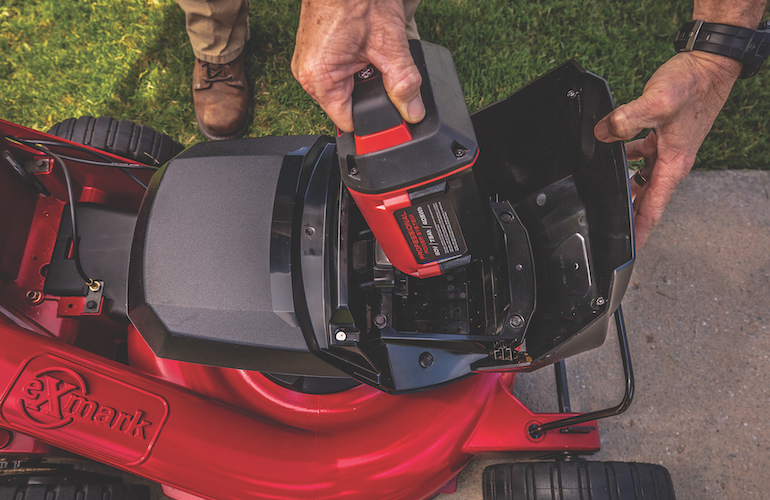
EXMARK
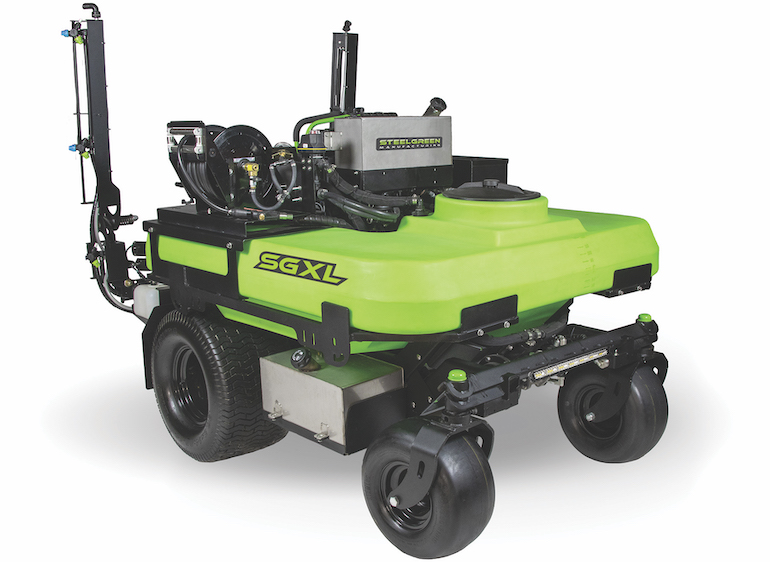
STEEL GREEN
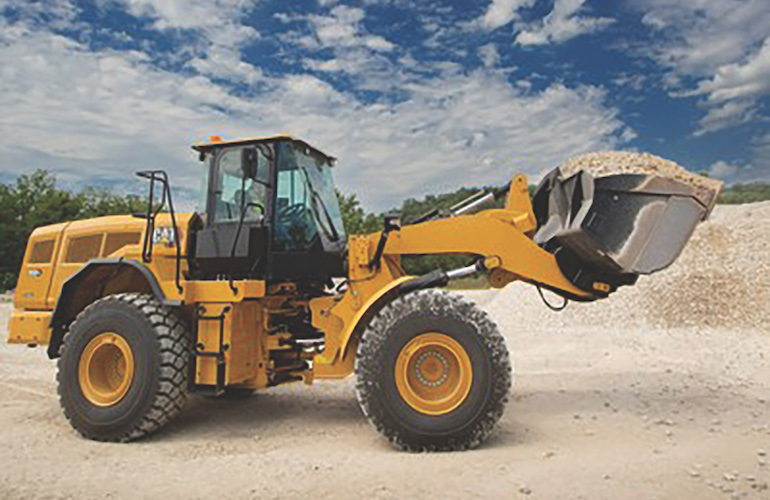
CATERPILLAR
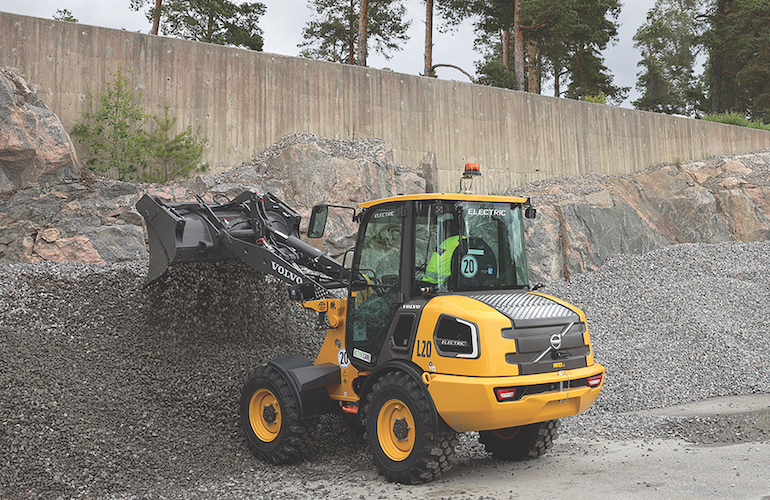
VOLVO CONSTRUCTION EQUIPMENT
Financing
Unfortunately, as with any emerging market, new technology does not come cheap. While long term savings are projected in terms of reduced labor cost and lower maintenance, up front costs can be far greater. “Autonomous solutions are beginning to enter the category in an effort to reduce the labor input. These solutions, so far, have typically been very expensive,” comments Kubota’s Vachal. As a result, financing solutions are evolving to meet the new purchasing dynamic involved with battery power.
For instance, Scythe’s M.52 mower is offered to landscape contractors on a unique pay-as-you-mow pricing model, meaning contractors are only charged for the acres they mow. Akin to how contractors bid a job, the price per acre varies depending on the property’s complexity and other factors. Essentially, the M.52 only bills when it’s working and Scythe projects that contractors will realize a 40% savings over their current mowing costs.
Since this pricing model eliminates significant upfront cash outlays, it allows contractors a more cash-flow friendly approach to buying new equipment. Contractors can also more easily track and budget mowing expenditures with this model, says Scythe. As to ongoing maintenance, Scythe says contractors only need to sharpen the blades and keep the tires inflated. Scythe will handle the repairs and software updates for M.52.
DEWALT is also giving landscapers the choice on how to invest in batteries. In connection with the DEWALT Ascent Series (mentioned previously), the Ascent Series PowerEquip™ battery subscription program that will provide flexible terms to help landscapers reduce upfront battery investments. Additionally, the PowerEquip subscription program would aim to provide peace-of-mind that easy battery exchanges and support are available. DEWALT also collaborated with policymakers and other stakeholders on potential incentives. “We are also excited that the Ascent mowers may soon be eligible for a new tax credit of up to $7,500 for eligible commercial businesses,” says Steve Adcock, vice president of Outdoor business development for Stanley Black & Decker.
Volvo Construction Equipment has also launched a new financing option for the company’s electric compact equipment to simplify the ownership experience. The all-inclusive leasing package bundles charging, maintenance, repairs, and more. Available through Volvo Financial Services (VFS), the process is the same as with other Volvo CE machines. Customers work with their local Volvo CE dealer and VFS to set the length of the contract, determine how many hours each machine could operate, and negotiate monthly payments. Then, within the all-inclusive package, among other incentives, customers have the option to finance a charger alongside the lease with a single monthly payment. The charger is purchased, not leased, but it’s financed within the same terms and rates as the complete package.
As an example, a contractor who signs a 48-month lease will have the option to pay for the charger in 48 monthly payments as well. The leasing packages also comes with an early termination option at 24 months.
Of course, coupled with purchasing new equipment is the fear of inflation and its effects. As a result, WorkWave’s Agajanion foresees that “many field service software companies will prioritize the integration of financing and payment plan options to give maximum flexibility to consumers in an uncertain economic environment.”
Tech
As to tech’s role in 2023, Agajanian says, “Service estimates, booking, payments and customer service will be mostly online and digital [and] landscape mowing and maintenance continue to be the highest revenue-producing service.” He adds, “Major companies are exploring various ways to maximize efficiency – this includes streamlining processes through software automation or various electronic systems including sensor monitoring, irrigation, and automatic mowers.”
Scythe’s Otteman agrees. “Landscape businesses are attuned to metrics and data that can increase their gross margin and contribute to the overall financial success of their business. Products, tools, and soft-ware platforms that can generate data from the field and lead to improved efficiency, increase profitability, and added insights are instrumental to achieving these goals.”
Increased efficiency and data from the field are not the only perks of high-tech. It can also help bring in talented employees. “Younger employees are attracted to the technical tools—drones, autonomous mowers, communications systems—landscape businesses are adopting. These tools make it easier to recruit and puts the landscape industry in a better light,” says Otteman.
More on gas mowers to come in the February issue including: STIHL’s 2023 entry into the zero-turn market with the RZ 500, RZ 700, and RZ 900 Series. Also, two new Kubota mowers: the ZD1611, the company’s highest HP diesel zero-turn, and the new F3710, a rear-wheel steer front attachment machine.
Do you have a comment? Share your thoughts in the Comments section below, or send an e-mail to the Editor at cmenapace@groupc.com.